3D Printer Assignment: Components, History, and Improvement
VerifiedAdded on 2023/04/24
|17
|5748
|60
Project
AI Summary
This project provides a comprehensive overview of 3D printing technology. It begins with an introduction to 3D printers and their working principles, including the creation of three-dimensional objects through layer-by-layer material processing. The assignment then details the essential components of a 3D printer, such as the controller board, filament, frame, motion components (including stepper motors, belts, and threaded rods), end stops, power supply unit, print bed, print bed surface, and print head (extruder). Furthermore, the project delves into the history of 3D printing, highlighting its evolution and impact on the engineering environment, including the development of additive manufacturing techniques. It also explains the structure of ABS and PLA filaments, accompanied by diagrams, and discusses methods for improving 3D printing in a closed environment or enclosure. Finally, it includes a bibliography of cited sources.
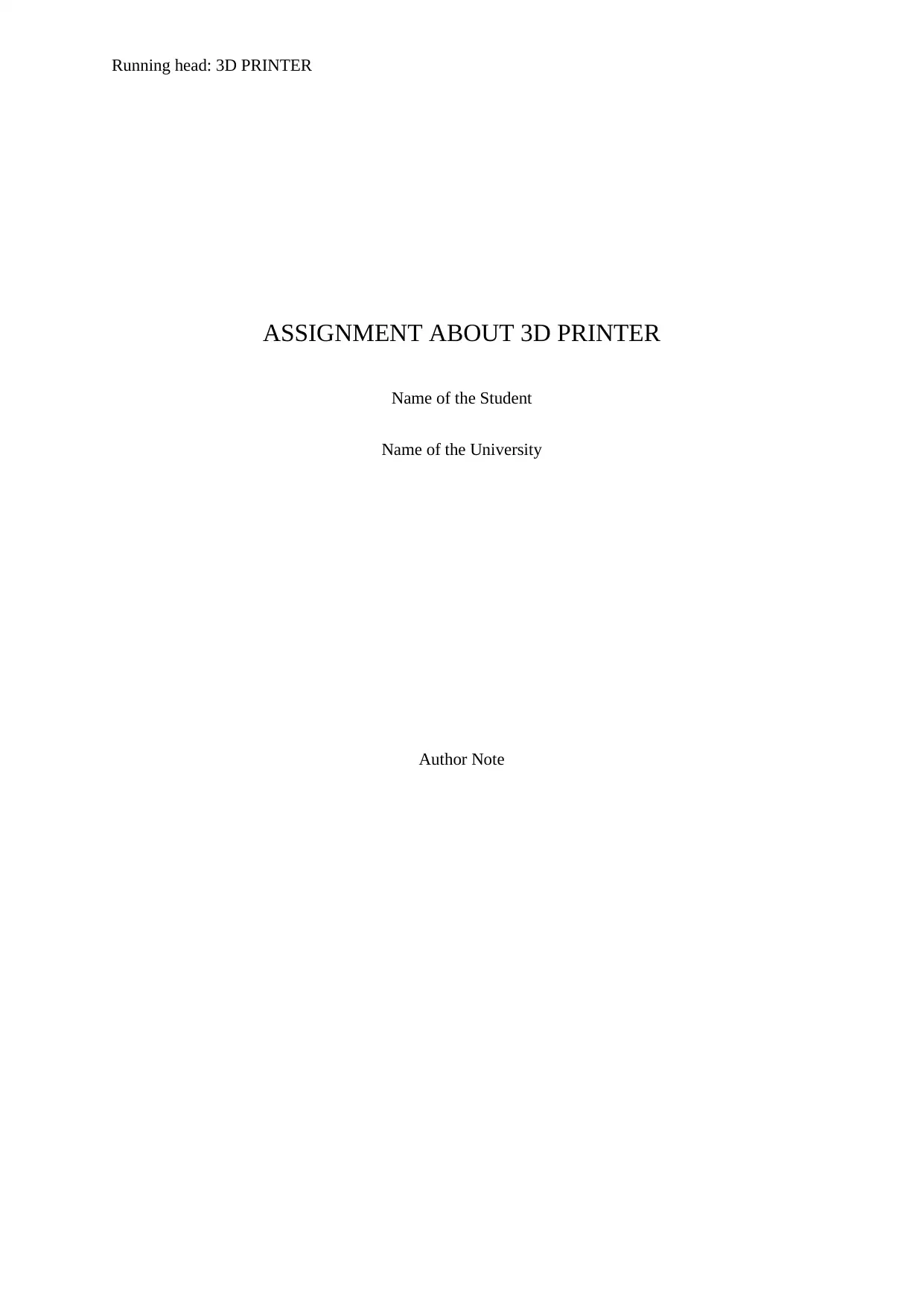
Running head: 3D PRINTER
ASSIGNMENT ABOUT 3D PRINTER
Name of the Student
Name of the University
Author Note
ASSIGNMENT ABOUT 3D PRINTER
Name of the Student
Name of the University
Author Note
Paraphrase This Document
Need a fresh take? Get an instant paraphrase of this document with our AI Paraphraser
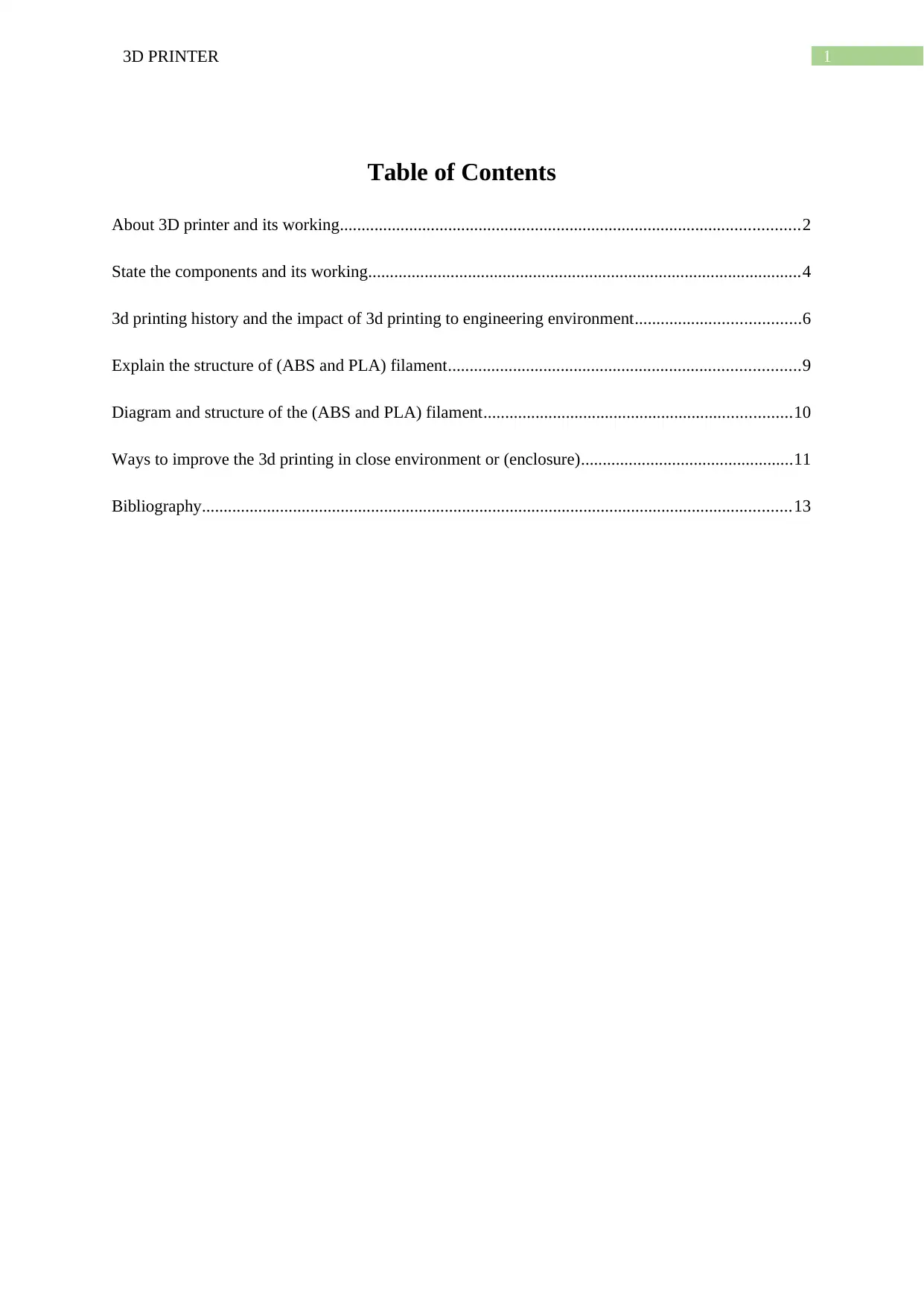
13D PRINTER
Table of Contents
About 3D printer and its working..........................................................................................................2
State the components and its working....................................................................................................4
3d printing history and the impact of 3d printing to engineering environment......................................6
Explain the structure of (ABS and PLA) filament.................................................................................9
Diagram and structure of the (ABS and PLA) filament.......................................................................10
Ways to improve the 3d printing in close environment or (enclosure).................................................11
Bibliography........................................................................................................................................13
Table of Contents
About 3D printer and its working..........................................................................................................2
State the components and its working....................................................................................................4
3d printing history and the impact of 3d printing to engineering environment......................................6
Explain the structure of (ABS and PLA) filament.................................................................................9
Diagram and structure of the (ABS and PLA) filament.......................................................................10
Ways to improve the 3d printing in close environment or (enclosure).................................................11
Bibliography........................................................................................................................................13
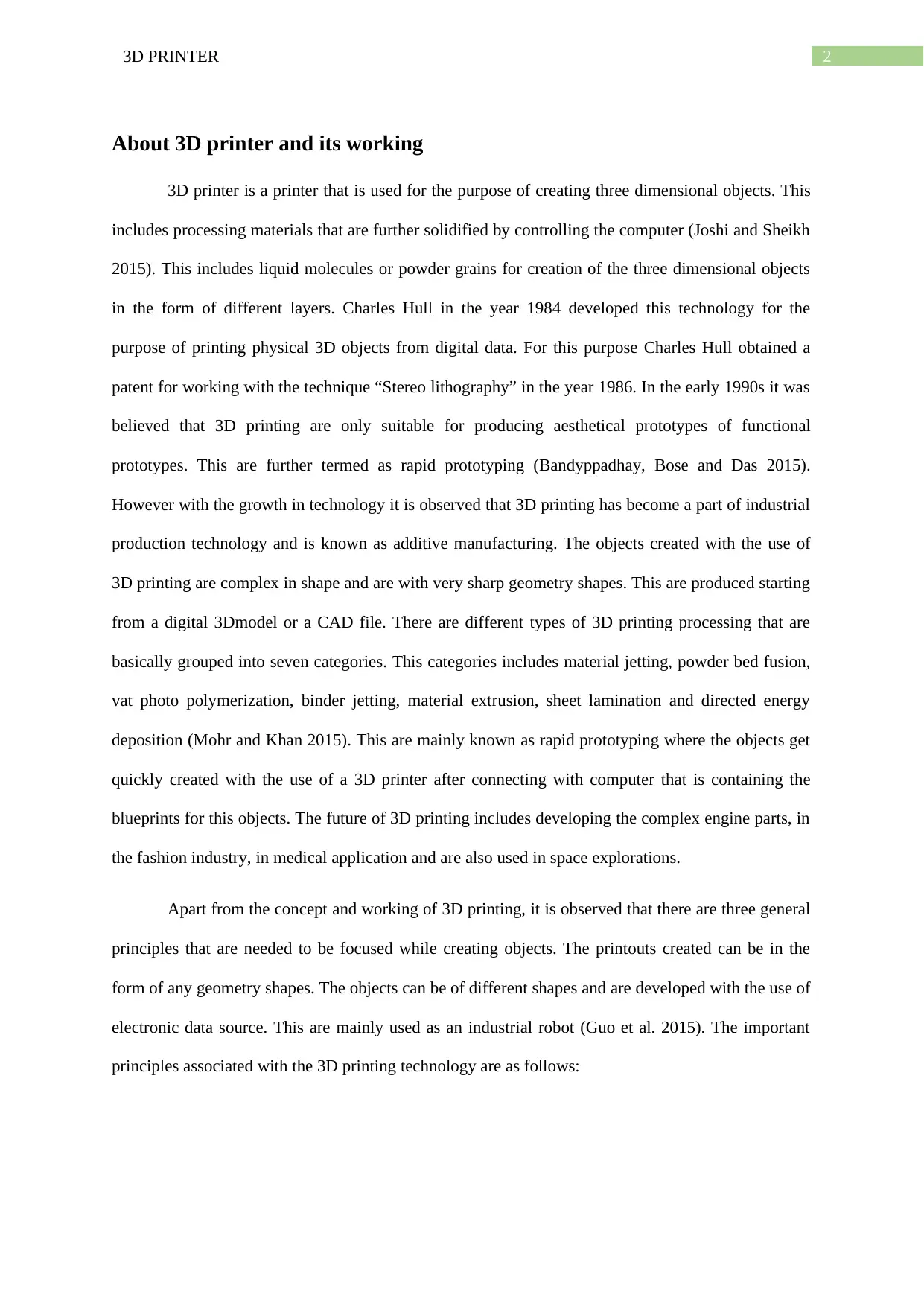
23D PRINTER
About 3D printer and its working
3D printer is a printer that is used for the purpose of creating three dimensional objects. This
includes processing materials that are further solidified by controlling the computer (Joshi and Sheikh
2015). This includes liquid molecules or powder grains for creation of the three dimensional objects
in the form of different layers. Charles Hull in the year 1984 developed this technology for the
purpose of printing physical 3D objects from digital data. For this purpose Charles Hull obtained a
patent for working with the technique “Stereo lithography” in the year 1986. In the early 1990s it was
believed that 3D printing are only suitable for producing aesthetical prototypes of functional
prototypes. This are further termed as rapid prototyping (Bandyppadhay, Bose and Das 2015).
However with the growth in technology it is observed that 3D printing has become a part of industrial
production technology and is known as additive manufacturing. The objects created with the use of
3D printing are complex in shape and are with very sharp geometry shapes. This are produced starting
from a digital 3Dmodel or a CAD file. There are different types of 3D printing processing that are
basically grouped into seven categories. This categories includes material jetting, powder bed fusion,
vat photo polymerization, binder jetting, material extrusion, sheet lamination and directed energy
deposition (Mohr and Khan 2015). This are mainly known as rapid prototyping where the objects get
quickly created with the use of a 3D printer after connecting with computer that is containing the
blueprints for this objects. The future of 3D printing includes developing the complex engine parts, in
the fashion industry, in medical application and are also used in space explorations.
Apart from the concept and working of 3D printing, it is observed that there are three general
principles that are needed to be focused while creating objects. The printouts created can be in the
form of any geometry shapes. The objects can be of different shapes and are developed with the use of
electronic data source. This are mainly used as an industrial robot (Guo et al. 2015). The important
principles associated with the 3D printing technology are as follows:
About 3D printer and its working
3D printer is a printer that is used for the purpose of creating three dimensional objects. This
includes processing materials that are further solidified by controlling the computer (Joshi and Sheikh
2015). This includes liquid molecules or powder grains for creation of the three dimensional objects
in the form of different layers. Charles Hull in the year 1984 developed this technology for the
purpose of printing physical 3D objects from digital data. For this purpose Charles Hull obtained a
patent for working with the technique “Stereo lithography” in the year 1986. In the early 1990s it was
believed that 3D printing are only suitable for producing aesthetical prototypes of functional
prototypes. This are further termed as rapid prototyping (Bandyppadhay, Bose and Das 2015).
However with the growth in technology it is observed that 3D printing has become a part of industrial
production technology and is known as additive manufacturing. The objects created with the use of
3D printing are complex in shape and are with very sharp geometry shapes. This are produced starting
from a digital 3Dmodel or a CAD file. There are different types of 3D printing processing that are
basically grouped into seven categories. This categories includes material jetting, powder bed fusion,
vat photo polymerization, binder jetting, material extrusion, sheet lamination and directed energy
deposition (Mohr and Khan 2015). This are mainly known as rapid prototyping where the objects get
quickly created with the use of a 3D printer after connecting with computer that is containing the
blueprints for this objects. The future of 3D printing includes developing the complex engine parts, in
the fashion industry, in medical application and are also used in space explorations.
Apart from the concept and working of 3D printing, it is observed that there are three general
principles that are needed to be focused while creating objects. The printouts created can be in the
form of any geometry shapes. The objects can be of different shapes and are developed with the use of
electronic data source. This are mainly used as an industrial robot (Guo et al. 2015). The important
principles associated with the 3D printing technology are as follows:
⊘ This is a preview!⊘
Do you want full access?
Subscribe today to unlock all pages.

Trusted by 1+ million students worldwide
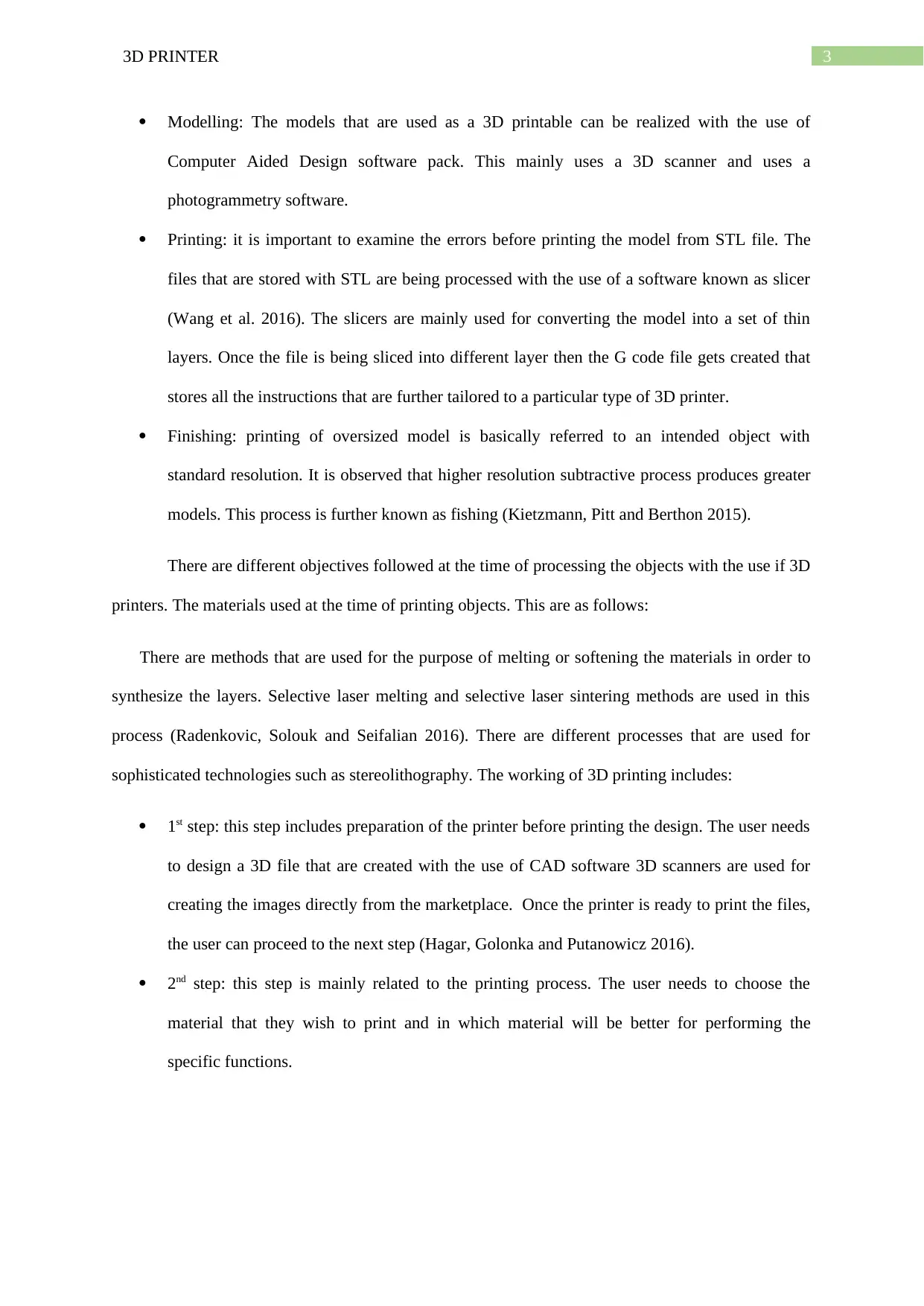
33D PRINTER
Modelling: The models that are used as a 3D printable can be realized with the use of
Computer Aided Design software pack. This mainly uses a 3D scanner and uses a
photogrammetry software.
Printing: it is important to examine the errors before printing the model from STL file. The
files that are stored with STL are being processed with the use of a software known as slicer
(Wang et al. 2016). The slicers are mainly used for converting the model into a set of thin
layers. Once the file is being sliced into different layer then the G code file gets created that
stores all the instructions that are further tailored to a particular type of 3D printer.
Finishing: printing of oversized model is basically referred to an intended object with
standard resolution. It is observed that higher resolution subtractive process produces greater
models. This process is further known as fishing (Kietzmann, Pitt and Berthon 2015).
There are different objectives followed at the time of processing the objects with the use if 3D
printers. The materials used at the time of printing objects. This are as follows:
There are methods that are used for the purpose of melting or softening the materials in order to
synthesize the layers. Selective laser melting and selective laser sintering methods are used in this
process (Radenkovic, Solouk and Seifalian 2016). There are different processes that are used for
sophisticated technologies such as stereolithography. The working of 3D printing includes:
1st step: this step includes preparation of the printer before printing the design. The user needs
to design a 3D file that are created with the use of CAD software 3D scanners are used for
creating the images directly from the marketplace. Once the printer is ready to print the files,
the user can proceed to the next step (Hagar, Golonka and Putanowicz 2016).
2nd step: this step is mainly related to the printing process. The user needs to choose the
material that they wish to print and in which material will be better for performing the
specific functions.
Modelling: The models that are used as a 3D printable can be realized with the use of
Computer Aided Design software pack. This mainly uses a 3D scanner and uses a
photogrammetry software.
Printing: it is important to examine the errors before printing the model from STL file. The
files that are stored with STL are being processed with the use of a software known as slicer
(Wang et al. 2016). The slicers are mainly used for converting the model into a set of thin
layers. Once the file is being sliced into different layer then the G code file gets created that
stores all the instructions that are further tailored to a particular type of 3D printer.
Finishing: printing of oversized model is basically referred to an intended object with
standard resolution. It is observed that higher resolution subtractive process produces greater
models. This process is further known as fishing (Kietzmann, Pitt and Berthon 2015).
There are different objectives followed at the time of processing the objects with the use if 3D
printers. The materials used at the time of printing objects. This are as follows:
There are methods that are used for the purpose of melting or softening the materials in order to
synthesize the layers. Selective laser melting and selective laser sintering methods are used in this
process (Radenkovic, Solouk and Seifalian 2016). There are different processes that are used for
sophisticated technologies such as stereolithography. The working of 3D printing includes:
1st step: this step includes preparation of the printer before printing the design. The user needs
to design a 3D file that are created with the use of CAD software 3D scanners are used for
creating the images directly from the marketplace. Once the printer is ready to print the files,
the user can proceed to the next step (Hagar, Golonka and Putanowicz 2016).
2nd step: this step is mainly related to the printing process. The user needs to choose the
material that they wish to print and in which material will be better for performing the
specific functions.
Paraphrase This Document
Need a fresh take? Get an instant paraphrase of this document with our AI Paraphraser
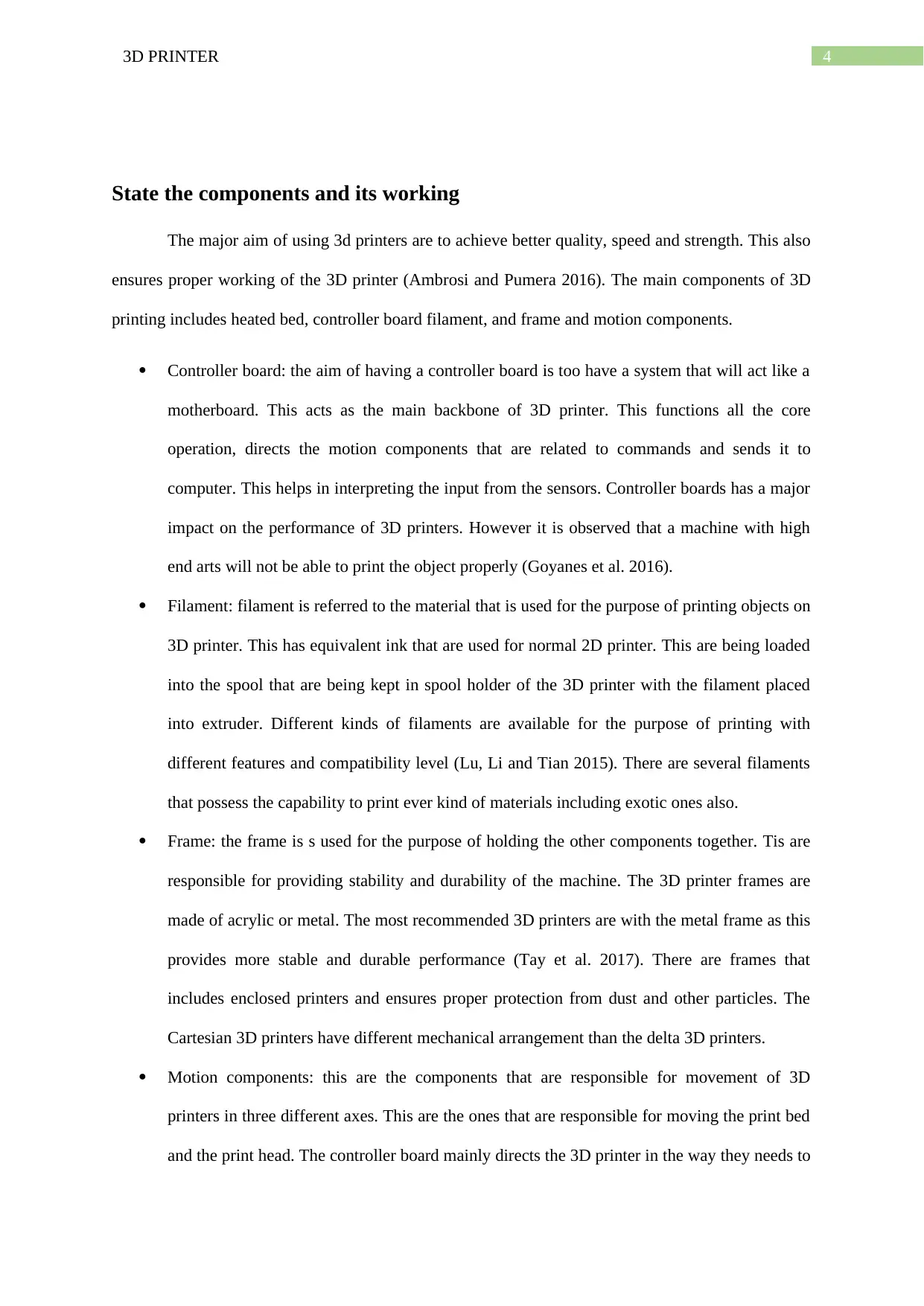
43D PRINTER
State the components and its working
The major aim of using 3d printers are to achieve better quality, speed and strength. This also
ensures proper working of the 3D printer (Ambrosi and Pumera 2016). The main components of 3D
printing includes heated bed, controller board filament, and frame and motion components.
Controller board: the aim of having a controller board is too have a system that will act like a
motherboard. This acts as the main backbone of 3D printer. This functions all the core
operation, directs the motion components that are related to commands and sends it to
computer. This helps in interpreting the input from the sensors. Controller boards has a major
impact on the performance of 3D printers. However it is observed that a machine with high
end arts will not be able to print the object properly (Goyanes et al. 2016).
Filament: filament is referred to the material that is used for the purpose of printing objects on
3D printer. This has equivalent ink that are used for normal 2D printer. This are being loaded
into the spool that are being kept in spool holder of the 3D printer with the filament placed
into extruder. Different kinds of filaments are available for the purpose of printing with
different features and compatibility level (Lu, Li and Tian 2015). There are several filaments
that possess the capability to print ever kind of materials including exotic ones also.
Frame: the frame is s used for the purpose of holding the other components together. Tis are
responsible for providing stability and durability of the machine. The 3D printer frames are
made of acrylic or metal. The most recommended 3D printers are with the metal frame as this
provides more stable and durable performance (Tay et al. 2017). There are frames that
includes enclosed printers and ensures proper protection from dust and other particles. The
Cartesian 3D printers have different mechanical arrangement than the delta 3D printers.
Motion components: this are the components that are responsible for movement of 3D
printers in three different axes. This are the ones that are responsible for moving the print bed
and the print head. The controller board mainly directs the 3D printer in the way they needs to
State the components and its working
The major aim of using 3d printers are to achieve better quality, speed and strength. This also
ensures proper working of the 3D printer (Ambrosi and Pumera 2016). The main components of 3D
printing includes heated bed, controller board filament, and frame and motion components.
Controller board: the aim of having a controller board is too have a system that will act like a
motherboard. This acts as the main backbone of 3D printer. This functions all the core
operation, directs the motion components that are related to commands and sends it to
computer. This helps in interpreting the input from the sensors. Controller boards has a major
impact on the performance of 3D printers. However it is observed that a machine with high
end arts will not be able to print the object properly (Goyanes et al. 2016).
Filament: filament is referred to the material that is used for the purpose of printing objects on
3D printer. This has equivalent ink that are used for normal 2D printer. This are being loaded
into the spool that are being kept in spool holder of the 3D printer with the filament placed
into extruder. Different kinds of filaments are available for the purpose of printing with
different features and compatibility level (Lu, Li and Tian 2015). There are several filaments
that possess the capability to print ever kind of materials including exotic ones also.
Frame: the frame is s used for the purpose of holding the other components together. Tis are
responsible for providing stability and durability of the machine. The 3D printer frames are
made of acrylic or metal. The most recommended 3D printers are with the metal frame as this
provides more stable and durable performance (Tay et al. 2017). There are frames that
includes enclosed printers and ensures proper protection from dust and other particles. The
Cartesian 3D printers have different mechanical arrangement than the delta 3D printers.
Motion components: this are the components that are responsible for movement of 3D
printers in three different axes. This are the ones that are responsible for moving the print bed
and the print head. The controller board mainly directs the 3D printer in the way they needs to
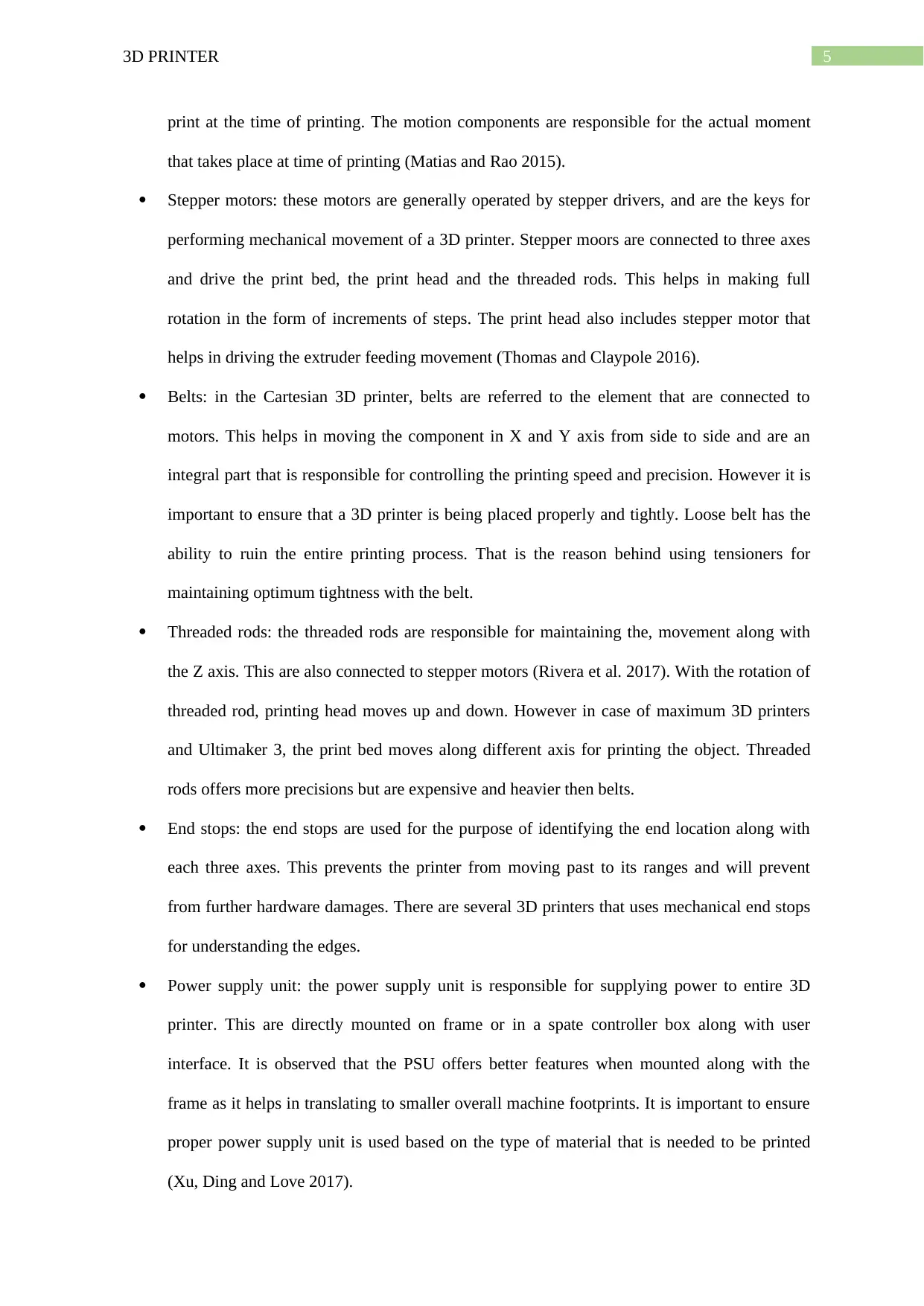
53D PRINTER
print at the time of printing. The motion components are responsible for the actual moment
that takes place at time of printing (Matias and Rao 2015).
Stepper motors: these motors are generally operated by stepper drivers, and are the keys for
performing mechanical movement of a 3D printer. Stepper moors are connected to three axes
and drive the print bed, the print head and the threaded rods. This helps in making full
rotation in the form of increments of steps. The print head also includes stepper motor that
helps in driving the extruder feeding movement (Thomas and Claypole 2016).
Belts: in the Cartesian 3D printer, belts are referred to the element that are connected to
motors. This helps in moving the component in X and Y axis from side to side and are an
integral part that is responsible for controlling the printing speed and precision. However it is
important to ensure that a 3D printer is being placed properly and tightly. Loose belt has the
ability to ruin the entire printing process. That is the reason behind using tensioners for
maintaining optimum tightness with the belt.
Threaded rods: the threaded rods are responsible for maintaining the, movement along with
the Z axis. This are also connected to stepper motors (Rivera et al. 2017). With the rotation of
threaded rod, printing head moves up and down. However in case of maximum 3D printers
and Ultimaker 3, the print bed moves along different axis for printing the object. Threaded
rods offers more precisions but are expensive and heavier then belts.
End stops: the end stops are used for the purpose of identifying the end location along with
each three axes. This prevents the printer from moving past to its ranges and will prevent
from further hardware damages. There are several 3D printers that uses mechanical end stops
for understanding the edges.
Power supply unit: the power supply unit is responsible for supplying power to entire 3D
printer. This are directly mounted on frame or in a spate controller box along with user
interface. It is observed that the PSU offers better features when mounted along with the
frame as it helps in translating to smaller overall machine footprints. It is important to ensure
proper power supply unit is used based on the type of material that is needed to be printed
(Xu, Ding and Love 2017).
print at the time of printing. The motion components are responsible for the actual moment
that takes place at time of printing (Matias and Rao 2015).
Stepper motors: these motors are generally operated by stepper drivers, and are the keys for
performing mechanical movement of a 3D printer. Stepper moors are connected to three axes
and drive the print bed, the print head and the threaded rods. This helps in making full
rotation in the form of increments of steps. The print head also includes stepper motor that
helps in driving the extruder feeding movement (Thomas and Claypole 2016).
Belts: in the Cartesian 3D printer, belts are referred to the element that are connected to
motors. This helps in moving the component in X and Y axis from side to side and are an
integral part that is responsible for controlling the printing speed and precision. However it is
important to ensure that a 3D printer is being placed properly and tightly. Loose belt has the
ability to ruin the entire printing process. That is the reason behind using tensioners for
maintaining optimum tightness with the belt.
Threaded rods: the threaded rods are responsible for maintaining the, movement along with
the Z axis. This are also connected to stepper motors (Rivera et al. 2017). With the rotation of
threaded rod, printing head moves up and down. However in case of maximum 3D printers
and Ultimaker 3, the print bed moves along different axis for printing the object. Threaded
rods offers more precisions but are expensive and heavier then belts.
End stops: the end stops are used for the purpose of identifying the end location along with
each three axes. This prevents the printer from moving past to its ranges and will prevent
from further hardware damages. There are several 3D printers that uses mechanical end stops
for understanding the edges.
Power supply unit: the power supply unit is responsible for supplying power to entire 3D
printer. This are directly mounted on frame or in a spate controller box along with user
interface. It is observed that the PSU offers better features when mounted along with the
frame as it helps in translating to smaller overall machine footprints. It is important to ensure
proper power supply unit is used based on the type of material that is needed to be printed
(Xu, Ding and Love 2017).
⊘ This is a preview!⊘
Do you want full access?
Subscribe today to unlock all pages.

Trusted by 1+ million students worldwide
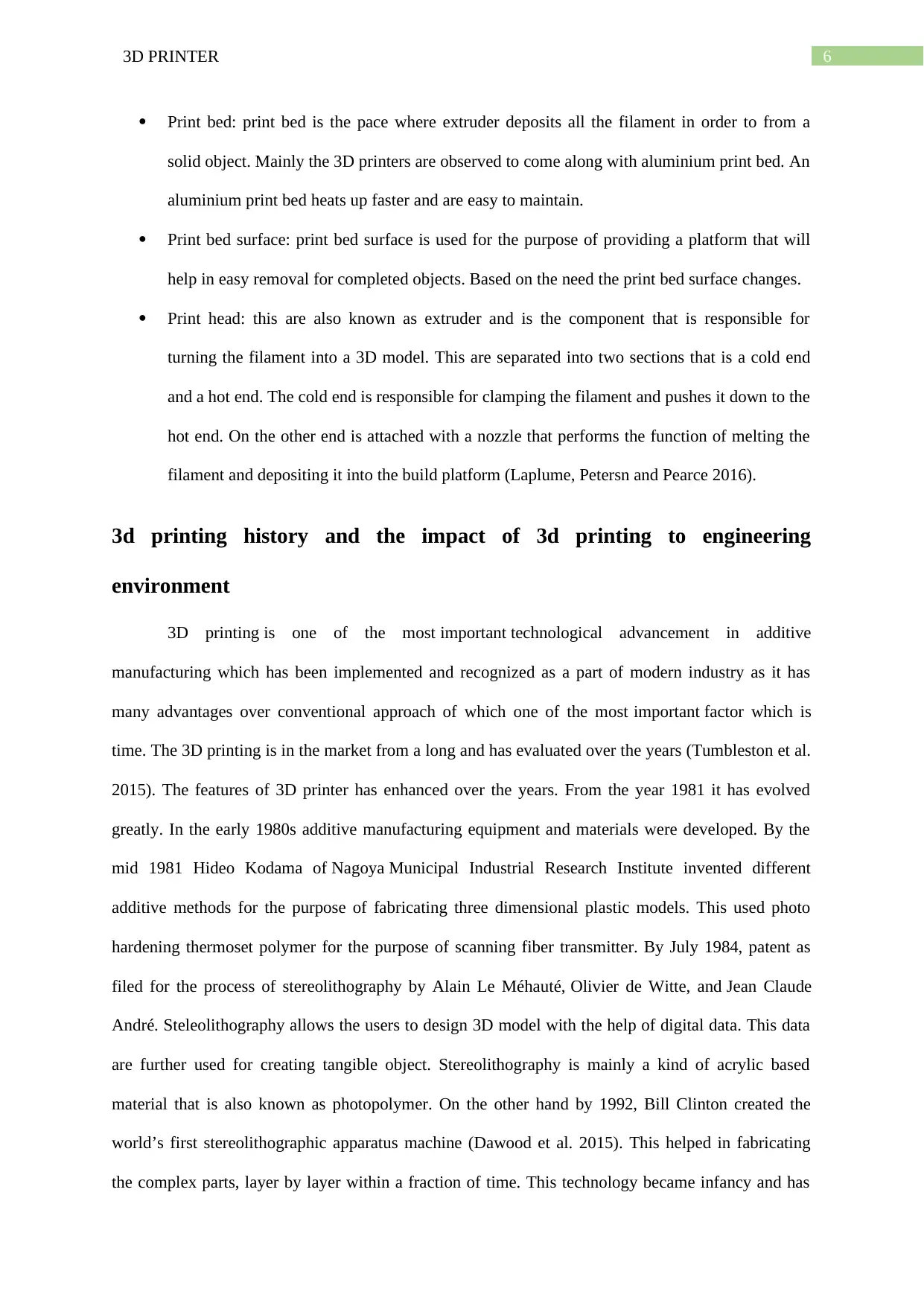
63D PRINTER
Print bed: print bed is the pace where extruder deposits all the filament in order to from a
solid object. Mainly the 3D printers are observed to come along with aluminium print bed. An
aluminium print bed heats up faster and are easy to maintain.
Print bed surface: print bed surface is used for the purpose of providing a platform that will
help in easy removal for completed objects. Based on the need the print bed surface changes.
Print head: this are also known as extruder and is the component that is responsible for
turning the filament into a 3D model. This are separated into two sections that is a cold end
and a hot end. The cold end is responsible for clamping the filament and pushes it down to the
hot end. On the other end is attached with a nozzle that performs the function of melting the
filament and depositing it into the build platform (Laplume, Petersn and Pearce 2016).
3d printing history and the impact of 3d printing to engineering
environment
3D printing is one of the most important technological advancement in additive
manufacturing which has been implemented and recognized as a part of modern industry as it has
many advantages over conventional approach of which one of the most important factor which is
time. The 3D printing is in the market from a long and has evaluated over the years (Tumbleston et al.
2015). The features of 3D printer has enhanced over the years. From the year 1981 it has evolved
greatly. In the early 1980s additive manufacturing equipment and materials were developed. By the
mid 1981 Hideo Kodama of Nagoya Municipal Industrial Research Institute invented different
additive methods for the purpose of fabricating three dimensional plastic models. This used photo
hardening thermoset polymer for the purpose of scanning fiber transmitter. By July 1984, patent as
filed for the process of stereolithography by Alain Le Méhauté, Olivier de Witte, and Jean Claude
André. Steleolithography allows the users to design 3D model with the help of digital data. This data
are further used for creating tangible object. Stereolithography is mainly a kind of acrylic based
material that is also known as photopolymer. On the other hand by 1992, Bill Clinton created the
world’s first stereolithographic apparatus machine (Dawood et al. 2015). This helped in fabricating
the complex parts, layer by layer within a fraction of time. This technology became infancy and has
Print bed: print bed is the pace where extruder deposits all the filament in order to from a
solid object. Mainly the 3D printers are observed to come along with aluminium print bed. An
aluminium print bed heats up faster and are easy to maintain.
Print bed surface: print bed surface is used for the purpose of providing a platform that will
help in easy removal for completed objects. Based on the need the print bed surface changes.
Print head: this are also known as extruder and is the component that is responsible for
turning the filament into a 3D model. This are separated into two sections that is a cold end
and a hot end. The cold end is responsible for clamping the filament and pushes it down to the
hot end. On the other end is attached with a nozzle that performs the function of melting the
filament and depositing it into the build platform (Laplume, Petersn and Pearce 2016).
3d printing history and the impact of 3d printing to engineering
environment
3D printing is one of the most important technological advancement in additive
manufacturing which has been implemented and recognized as a part of modern industry as it has
many advantages over conventional approach of which one of the most important factor which is
time. The 3D printing is in the market from a long and has evaluated over the years (Tumbleston et al.
2015). The features of 3D printer has enhanced over the years. From the year 1981 it has evolved
greatly. In the early 1980s additive manufacturing equipment and materials were developed. By the
mid 1981 Hideo Kodama of Nagoya Municipal Industrial Research Institute invented different
additive methods for the purpose of fabricating three dimensional plastic models. This used photo
hardening thermoset polymer for the purpose of scanning fiber transmitter. By July 1984, patent as
filed for the process of stereolithography by Alain Le Méhauté, Olivier de Witte, and Jean Claude
André. Steleolithography allows the users to design 3D model with the help of digital data. This data
are further used for creating tangible object. Stereolithography is mainly a kind of acrylic based
material that is also known as photopolymer. On the other hand by 1992, Bill Clinton created the
world’s first stereolithographic apparatus machine (Dawood et al. 2015). This helped in fabricating
the complex parts, layer by layer within a fraction of time. This technology became infancy and has
Paraphrase This Document
Need a fresh take? Get an instant paraphrase of this document with our AI Paraphraser
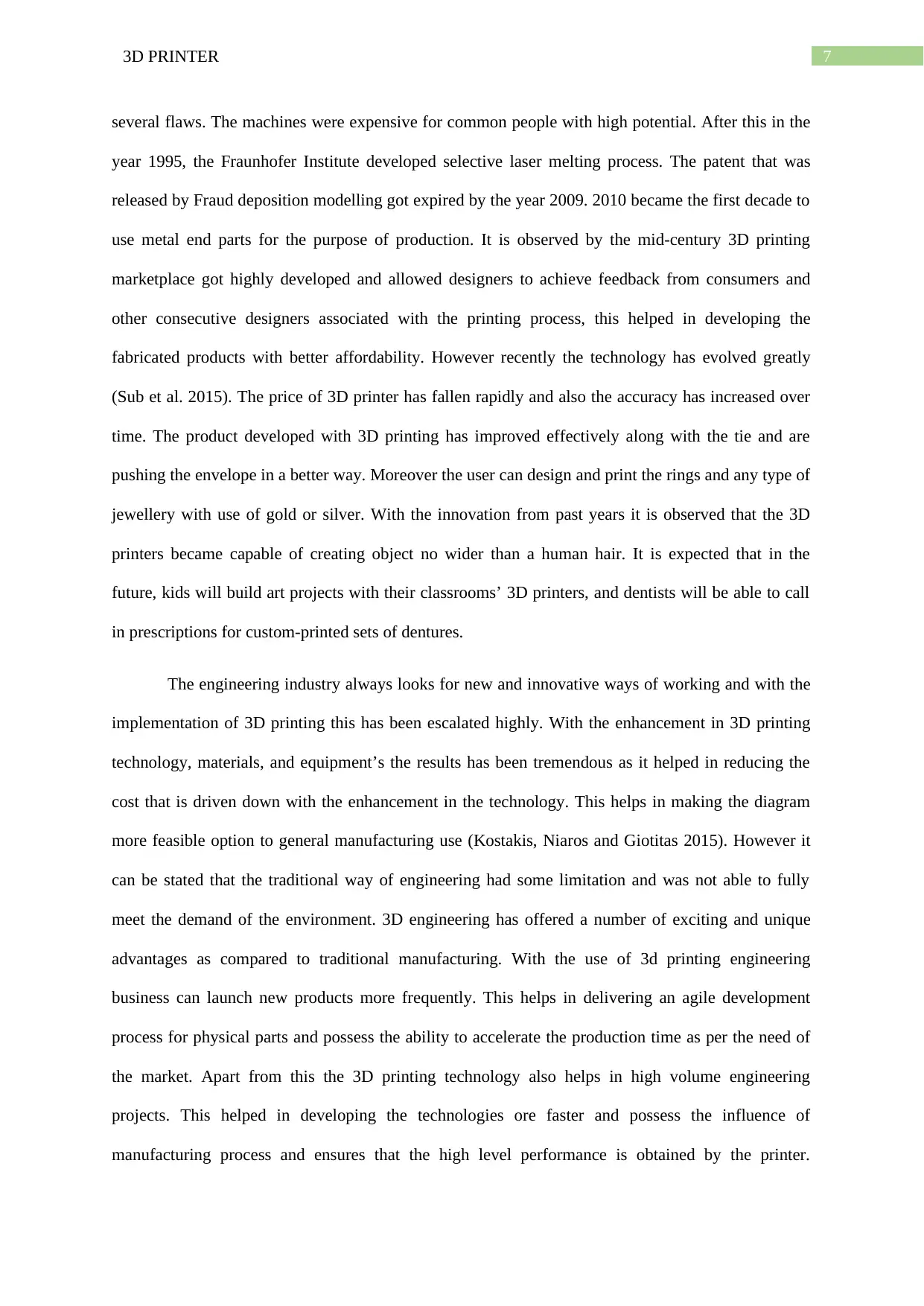
73D PRINTER
several flaws. The machines were expensive for common people with high potential. After this in the
year 1995, the Fraunhofer Institute developed selective laser melting process. The patent that was
released by Fraud deposition modelling got expired by the year 2009. 2010 became the first decade to
use metal end parts for the purpose of production. It is observed by the mid-century 3D printing
marketplace got highly developed and allowed designers to achieve feedback from consumers and
other consecutive designers associated with the printing process, this helped in developing the
fabricated products with better affordability. However recently the technology has evolved greatly
(Sub et al. 2015). The price of 3D printer has fallen rapidly and also the accuracy has increased over
time. The product developed with 3D printing has improved effectively along with the tie and are
pushing the envelope in a better way. Moreover the user can design and print the rings and any type of
jewellery with use of gold or silver. With the innovation from past years it is observed that the 3D
printers became capable of creating object no wider than a human hair. It is expected that in the
future, kids will build art projects with their classrooms’ 3D printers, and dentists will be able to call
in prescriptions for custom-printed sets of dentures.
The engineering industry always looks for new and innovative ways of working and with the
implementation of 3D printing this has been escalated highly. With the enhancement in 3D printing
technology, materials, and equipment’s the results has been tremendous as it helped in reducing the
cost that is driven down with the enhancement in the technology. This helps in making the diagram
more feasible option to general manufacturing use (Kostakis, Niaros and Giotitas 2015). However it
can be stated that the traditional way of engineering had some limitation and was not able to fully
meet the demand of the environment. 3D engineering has offered a number of exciting and unique
advantages as compared to traditional manufacturing. With the use of 3d printing engineering
business can launch new products more frequently. This helps in delivering an agile development
process for physical parts and possess the ability to accelerate the production time as per the need of
the market. Apart from this the 3D printing technology also helps in high volume engineering
projects. This helped in developing the technologies ore faster and possess the influence of
manufacturing process and ensures that the high level performance is obtained by the printer.
several flaws. The machines were expensive for common people with high potential. After this in the
year 1995, the Fraunhofer Institute developed selective laser melting process. The patent that was
released by Fraud deposition modelling got expired by the year 2009. 2010 became the first decade to
use metal end parts for the purpose of production. It is observed by the mid-century 3D printing
marketplace got highly developed and allowed designers to achieve feedback from consumers and
other consecutive designers associated with the printing process, this helped in developing the
fabricated products with better affordability. However recently the technology has evolved greatly
(Sub et al. 2015). The price of 3D printer has fallen rapidly and also the accuracy has increased over
time. The product developed with 3D printing has improved effectively along with the tie and are
pushing the envelope in a better way. Moreover the user can design and print the rings and any type of
jewellery with use of gold or silver. With the innovation from past years it is observed that the 3D
printers became capable of creating object no wider than a human hair. It is expected that in the
future, kids will build art projects with their classrooms’ 3D printers, and dentists will be able to call
in prescriptions for custom-printed sets of dentures.
The engineering industry always looks for new and innovative ways of working and with the
implementation of 3D printing this has been escalated highly. With the enhancement in 3D printing
technology, materials, and equipment’s the results has been tremendous as it helped in reducing the
cost that is driven down with the enhancement in the technology. This helps in making the diagram
more feasible option to general manufacturing use (Kostakis, Niaros and Giotitas 2015). However it
can be stated that the traditional way of engineering had some limitation and was not able to fully
meet the demand of the environment. 3D engineering has offered a number of exciting and unique
advantages as compared to traditional manufacturing. With the use of 3d printing engineering
business can launch new products more frequently. This helps in delivering an agile development
process for physical parts and possess the ability to accelerate the production time as per the need of
the market. Apart from this the 3D printing technology also helps in high volume engineering
projects. This helped in developing the technologies ore faster and possess the influence of
manufacturing process and ensures that the high level performance is obtained by the printer.
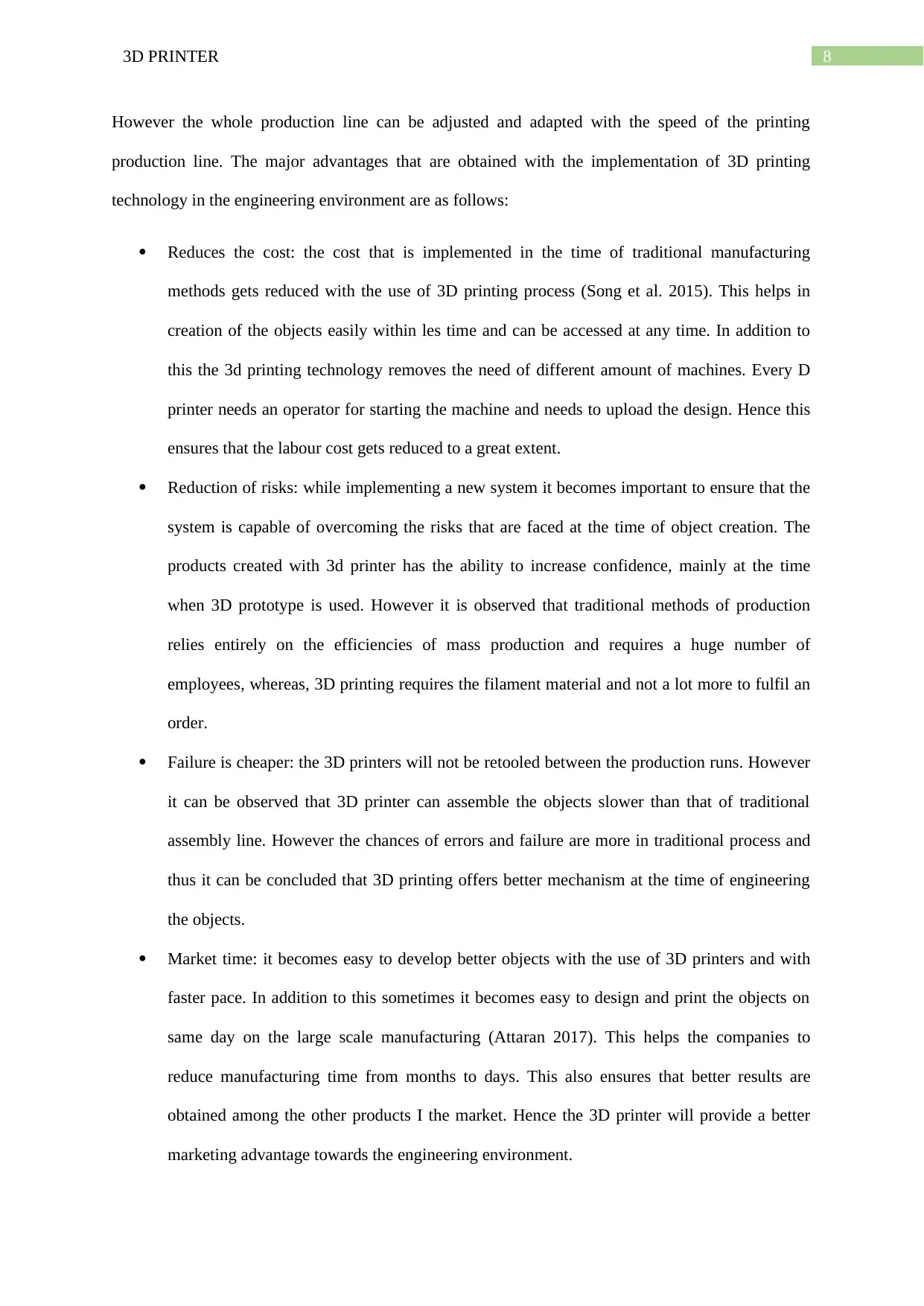
83D PRINTER
However the whole production line can be adjusted and adapted with the speed of the printing
production line. The major advantages that are obtained with the implementation of 3D printing
technology in the engineering environment are as follows:
Reduces the cost: the cost that is implemented in the time of traditional manufacturing
methods gets reduced with the use of 3D printing process (Song et al. 2015). This helps in
creation of the objects easily within les time and can be accessed at any time. In addition to
this the 3d printing technology removes the need of different amount of machines. Every D
printer needs an operator for starting the machine and needs to upload the design. Hence this
ensures that the labour cost gets reduced to a great extent.
Reduction of risks: while implementing a new system it becomes important to ensure that the
system is capable of overcoming the risks that are faced at the time of object creation. The
products created with 3d printer has the ability to increase confidence, mainly at the time
when 3D prototype is used. However it is observed that traditional methods of production
relies entirely on the efficiencies of mass production and requires a huge number of
employees, whereas, 3D printing requires the filament material and not a lot more to fulfil an
order.
Failure is cheaper: the 3D printers will not be retooled between the production runs. However
it can be observed that 3D printer can assemble the objects slower than that of traditional
assembly line. However the chances of errors and failure are more in traditional process and
thus it can be concluded that 3D printing offers better mechanism at the time of engineering
the objects.
Market time: it becomes easy to develop better objects with the use of 3D printers and with
faster pace. In addition to this sometimes it becomes easy to design and print the objects on
same day on the large scale manufacturing (Attaran 2017). This helps the companies to
reduce manufacturing time from months to days. This also ensures that better results are
obtained among the other products I the market. Hence the 3D printer will provide a better
marketing advantage towards the engineering environment.
However the whole production line can be adjusted and adapted with the speed of the printing
production line. The major advantages that are obtained with the implementation of 3D printing
technology in the engineering environment are as follows:
Reduces the cost: the cost that is implemented in the time of traditional manufacturing
methods gets reduced with the use of 3D printing process (Song et al. 2015). This helps in
creation of the objects easily within les time and can be accessed at any time. In addition to
this the 3d printing technology removes the need of different amount of machines. Every D
printer needs an operator for starting the machine and needs to upload the design. Hence this
ensures that the labour cost gets reduced to a great extent.
Reduction of risks: while implementing a new system it becomes important to ensure that the
system is capable of overcoming the risks that are faced at the time of object creation. The
products created with 3d printer has the ability to increase confidence, mainly at the time
when 3D prototype is used. However it is observed that traditional methods of production
relies entirely on the efficiencies of mass production and requires a huge number of
employees, whereas, 3D printing requires the filament material and not a lot more to fulfil an
order.
Failure is cheaper: the 3D printers will not be retooled between the production runs. However
it can be observed that 3D printer can assemble the objects slower than that of traditional
assembly line. However the chances of errors and failure are more in traditional process and
thus it can be concluded that 3D printing offers better mechanism at the time of engineering
the objects.
Market time: it becomes easy to develop better objects with the use of 3D printers and with
faster pace. In addition to this sometimes it becomes easy to design and print the objects on
same day on the large scale manufacturing (Attaran 2017). This helps the companies to
reduce manufacturing time from months to days. This also ensures that better results are
obtained among the other products I the market. Hence the 3D printer will provide a better
marketing advantage towards the engineering environment.
⊘ This is a preview!⊘
Do you want full access?
Subscribe today to unlock all pages.

Trusted by 1+ million students worldwide
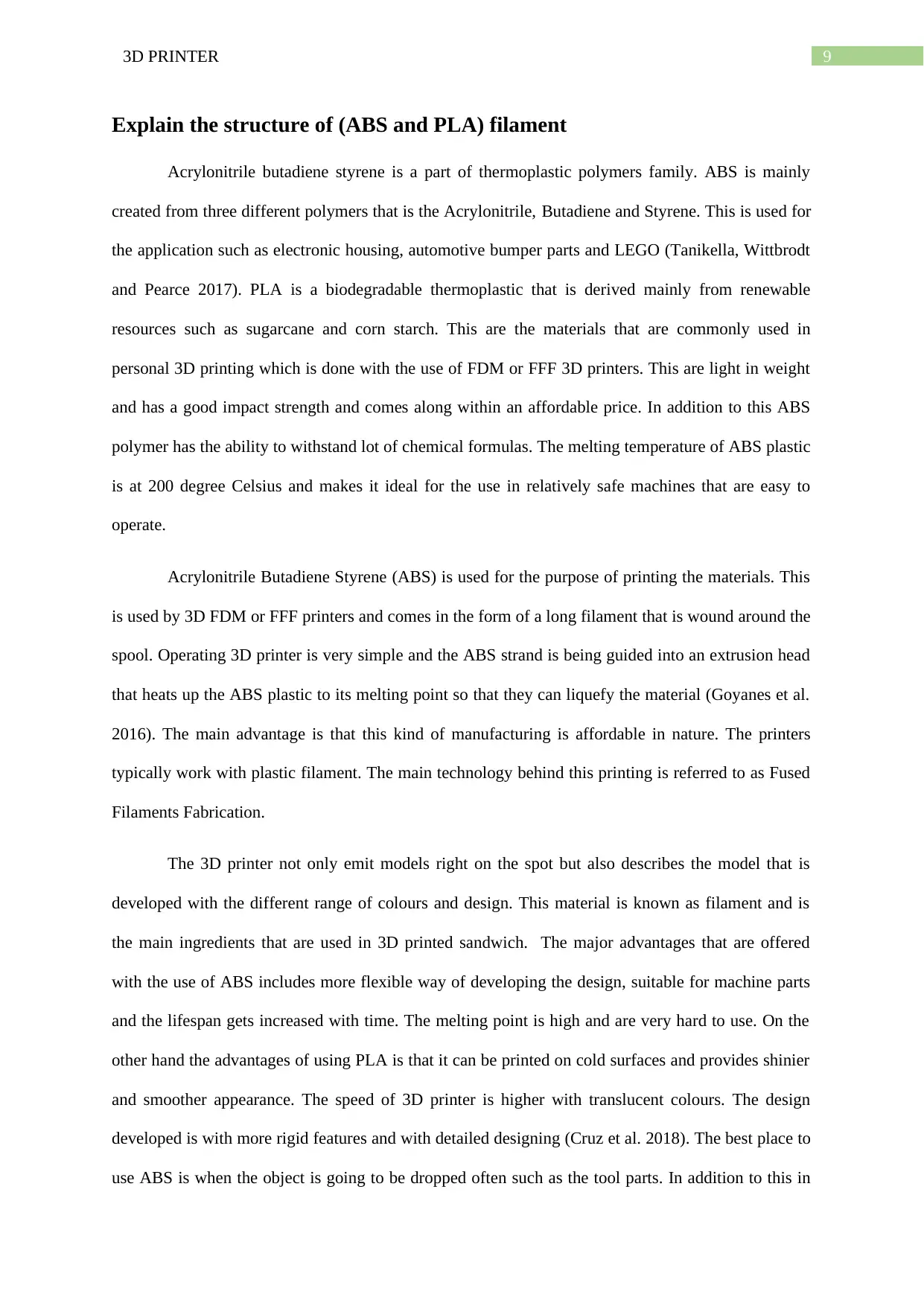
93D PRINTER
Explain the structure of (ABS and PLA) filament
Acrylonitrile butadiene styrene is a part of thermoplastic polymers family. ABS is mainly
created from three different polymers that is the Acrylonitrile, Butadiene and Styrene. This is used for
the application such as electronic housing, automotive bumper parts and LEGO (Tanikella, Wittbrodt
and Pearce 2017). PLA is a biodegradable thermoplastic that is derived mainly from renewable
resources such as sugarcane and corn starch. This are the materials that are commonly used in
personal 3D printing which is done with the use of FDM or FFF 3D printers. This are light in weight
and has a good impact strength and comes along within an affordable price. In addition to this ABS
polymer has the ability to withstand lot of chemical formulas. The melting temperature of ABS plastic
is at 200 degree Celsius and makes it ideal for the use in relatively safe machines that are easy to
operate.
Acrylonitrile Butadiene Styrene (ABS) is used for the purpose of printing the materials. This
is used by 3D FDM or FFF printers and comes in the form of a long filament that is wound around the
spool. Operating 3D printer is very simple and the ABS strand is being guided into an extrusion head
that heats up the ABS plastic to its melting point so that they can liquefy the material (Goyanes et al.
2016). The main advantage is that this kind of manufacturing is affordable in nature. The printers
typically work with plastic filament. The main technology behind this printing is referred to as Fused
Filaments Fabrication.
The 3D printer not only emit models right on the spot but also describes the model that is
developed with the different range of colours and design. This material is known as filament and is
the main ingredients that are used in 3D printed sandwich. The major advantages that are offered
with the use of ABS includes more flexible way of developing the design, suitable for machine parts
and the lifespan gets increased with time. The melting point is high and are very hard to use. On the
other hand the advantages of using PLA is that it can be printed on cold surfaces and provides shinier
and smoother appearance. The speed of 3D printer is higher with translucent colours. The design
developed is with more rigid features and with detailed designing (Cruz et al. 2018). The best place to
use ABS is when the object is going to be dropped often such as the tool parts. In addition to this in
Explain the structure of (ABS and PLA) filament
Acrylonitrile butadiene styrene is a part of thermoplastic polymers family. ABS is mainly
created from three different polymers that is the Acrylonitrile, Butadiene and Styrene. This is used for
the application such as electronic housing, automotive bumper parts and LEGO (Tanikella, Wittbrodt
and Pearce 2017). PLA is a biodegradable thermoplastic that is derived mainly from renewable
resources such as sugarcane and corn starch. This are the materials that are commonly used in
personal 3D printing which is done with the use of FDM or FFF 3D printers. This are light in weight
and has a good impact strength and comes along within an affordable price. In addition to this ABS
polymer has the ability to withstand lot of chemical formulas. The melting temperature of ABS plastic
is at 200 degree Celsius and makes it ideal for the use in relatively safe machines that are easy to
operate.
Acrylonitrile Butadiene Styrene (ABS) is used for the purpose of printing the materials. This
is used by 3D FDM or FFF printers and comes in the form of a long filament that is wound around the
spool. Operating 3D printer is very simple and the ABS strand is being guided into an extrusion head
that heats up the ABS plastic to its melting point so that they can liquefy the material (Goyanes et al.
2016). The main advantage is that this kind of manufacturing is affordable in nature. The printers
typically work with plastic filament. The main technology behind this printing is referred to as Fused
Filaments Fabrication.
The 3D printer not only emit models right on the spot but also describes the model that is
developed with the different range of colours and design. This material is known as filament and is
the main ingredients that are used in 3D printed sandwich. The major advantages that are offered
with the use of ABS includes more flexible way of developing the design, suitable for machine parts
and the lifespan gets increased with time. The melting point is high and are very hard to use. On the
other hand the advantages of using PLA is that it can be printed on cold surfaces and provides shinier
and smoother appearance. The speed of 3D printer is higher with translucent colours. The design
developed is with more rigid features and with detailed designing (Cruz et al. 2018). The best place to
use ABS is when the object is going to be dropped often such as the tool parts. In addition to this in
Paraphrase This Document
Need a fresh take? Get an instant paraphrase of this document with our AI Paraphraser
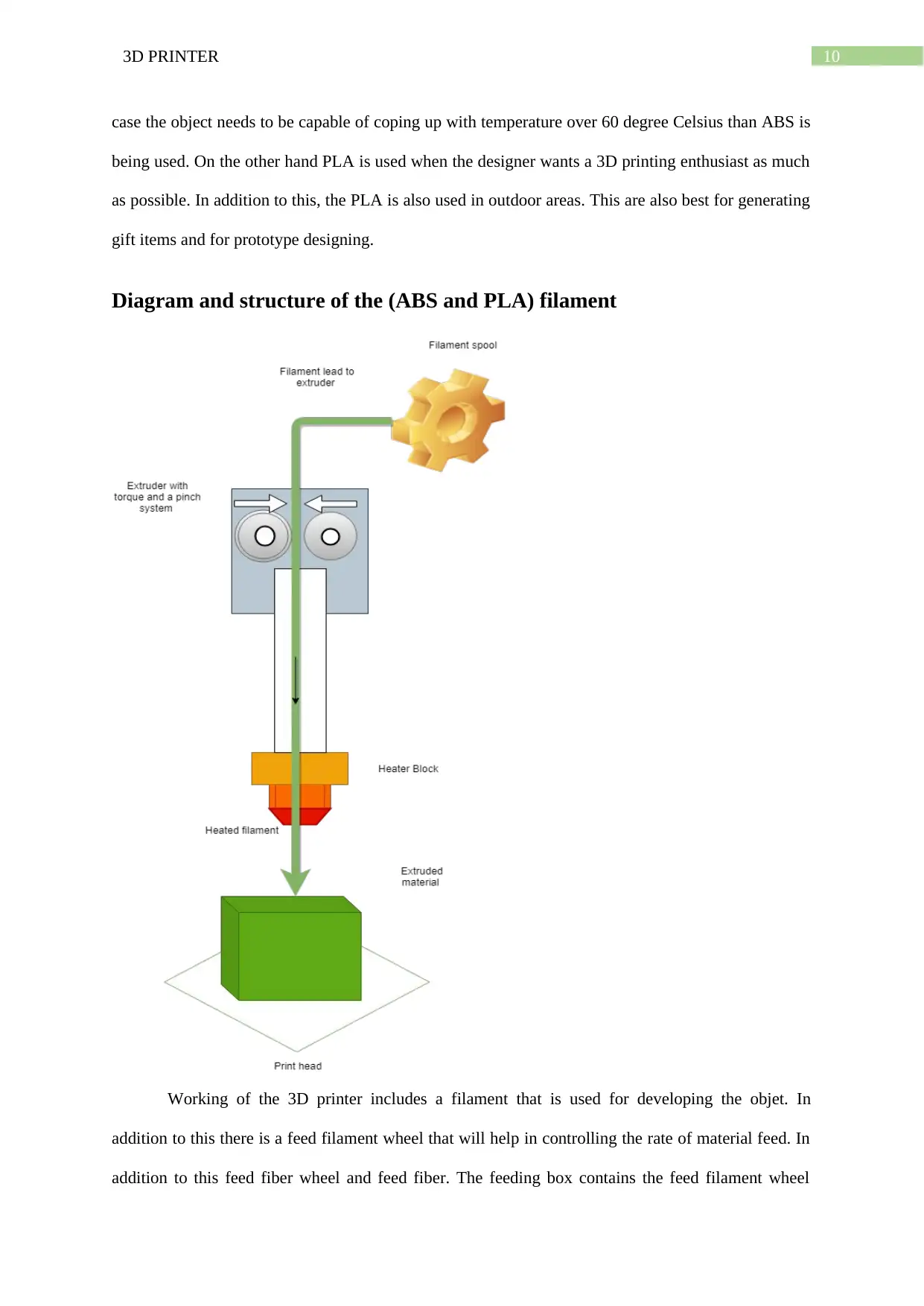
103D PRINTER
case the object needs to be capable of coping up with temperature over 60 degree Celsius than ABS is
being used. On the other hand PLA is used when the designer wants a 3D printing enthusiast as much
as possible. In addition to this, the PLA is also used in outdoor areas. This are also best for generating
gift items and for prototype designing.
Diagram and structure of the (ABS and PLA) filament
Working of the 3D printer includes a filament that is used for developing the objet. In
addition to this there is a feed filament wheel that will help in controlling the rate of material feed. In
addition to this feed fiber wheel and feed fiber. The feeding box contains the feed filament wheel
case the object needs to be capable of coping up with temperature over 60 degree Celsius than ABS is
being used. On the other hand PLA is used when the designer wants a 3D printing enthusiast as much
as possible. In addition to this, the PLA is also used in outdoor areas. This are also best for generating
gift items and for prototype designing.
Diagram and structure of the (ABS and PLA) filament
Working of the 3D printer includes a filament that is used for developing the objet. In
addition to this there is a feed filament wheel that will help in controlling the rate of material feed. In
addition to this feed fiber wheel and feed fiber. The feeding box contains the feed filament wheel
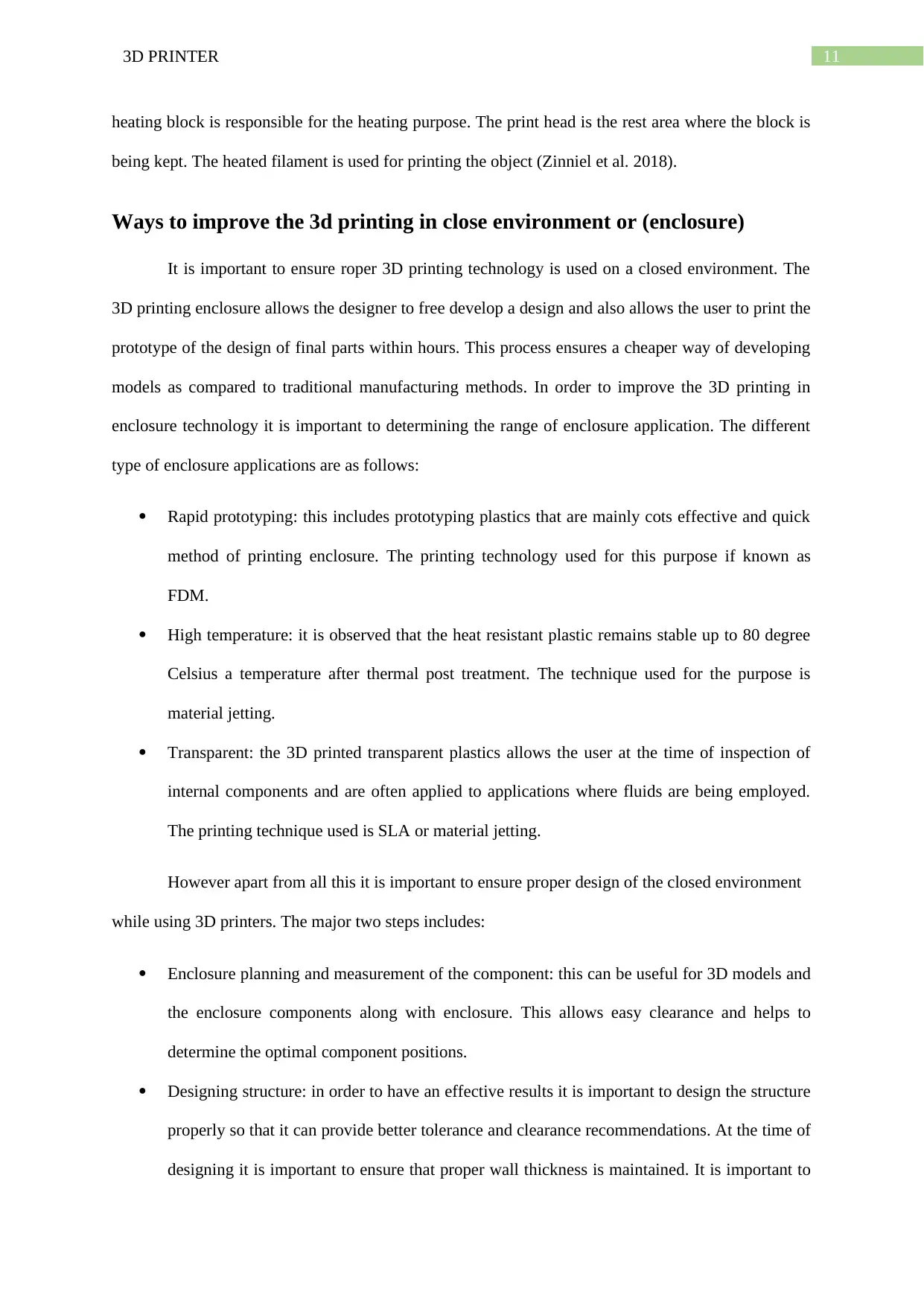
113D PRINTER
heating block is responsible for the heating purpose. The print head is the rest area where the block is
being kept. The heated filament is used for printing the object (Zinniel et al. 2018).
Ways to improve the 3d printing in close environment or (enclosure)
It is important to ensure roper 3D printing technology is used on a closed environment. The
3D printing enclosure allows the designer to free develop a design and also allows the user to print the
prototype of the design of final parts within hours. This process ensures a cheaper way of developing
models as compared to traditional manufacturing methods. In order to improve the 3D printing in
enclosure technology it is important to determining the range of enclosure application. The different
type of enclosure applications are as follows:
Rapid prototyping: this includes prototyping plastics that are mainly cots effective and quick
method of printing enclosure. The printing technology used for this purpose if known as
FDM.
High temperature: it is observed that the heat resistant plastic remains stable up to 80 degree
Celsius a temperature after thermal post treatment. The technique used for the purpose is
material jetting.
Transparent: the 3D printed transparent plastics allows the user at the time of inspection of
internal components and are often applied to applications where fluids are being employed.
The printing technique used is SLA or material jetting.
However apart from all this it is important to ensure proper design of the closed environment
while using 3D printers. The major two steps includes:
Enclosure planning and measurement of the component: this can be useful for 3D models and
the enclosure components along with enclosure. This allows easy clearance and helps to
determine the optimal component positions.
Designing structure: in order to have an effective results it is important to design the structure
properly so that it can provide better tolerance and clearance recommendations. At the time of
designing it is important to ensure that proper wall thickness is maintained. It is important to
heating block is responsible for the heating purpose. The print head is the rest area where the block is
being kept. The heated filament is used for printing the object (Zinniel et al. 2018).
Ways to improve the 3d printing in close environment or (enclosure)
It is important to ensure roper 3D printing technology is used on a closed environment. The
3D printing enclosure allows the designer to free develop a design and also allows the user to print the
prototype of the design of final parts within hours. This process ensures a cheaper way of developing
models as compared to traditional manufacturing methods. In order to improve the 3D printing in
enclosure technology it is important to determining the range of enclosure application. The different
type of enclosure applications are as follows:
Rapid prototyping: this includes prototyping plastics that are mainly cots effective and quick
method of printing enclosure. The printing technology used for this purpose if known as
FDM.
High temperature: it is observed that the heat resistant plastic remains stable up to 80 degree
Celsius a temperature after thermal post treatment. The technique used for the purpose is
material jetting.
Transparent: the 3D printed transparent plastics allows the user at the time of inspection of
internal components and are often applied to applications where fluids are being employed.
The printing technique used is SLA or material jetting.
However apart from all this it is important to ensure proper design of the closed environment
while using 3D printers. The major two steps includes:
Enclosure planning and measurement of the component: this can be useful for 3D models and
the enclosure components along with enclosure. This allows easy clearance and helps to
determine the optimal component positions.
Designing structure: in order to have an effective results it is important to design the structure
properly so that it can provide better tolerance and clearance recommendations. At the time of
designing it is important to ensure that proper wall thickness is maintained. It is important to
⊘ This is a preview!⊘
Do you want full access?
Subscribe today to unlock all pages.

Trusted by 1+ million students worldwide
1 out of 17
Related Documents
Your All-in-One AI-Powered Toolkit for Academic Success.
+13062052269
info@desklib.com
Available 24*7 on WhatsApp / Email
![[object Object]](/_next/static/media/star-bottom.7253800d.svg)
Unlock your academic potential
Copyright © 2020–2025 A2Z Services. All Rights Reserved. Developed and managed by ZUCOL.





